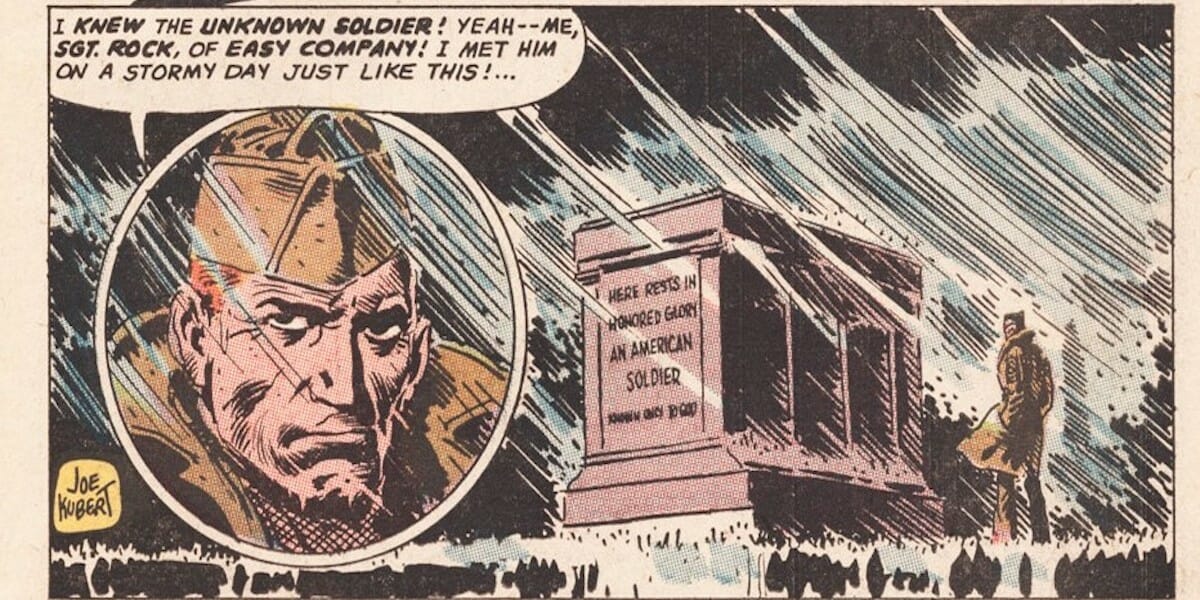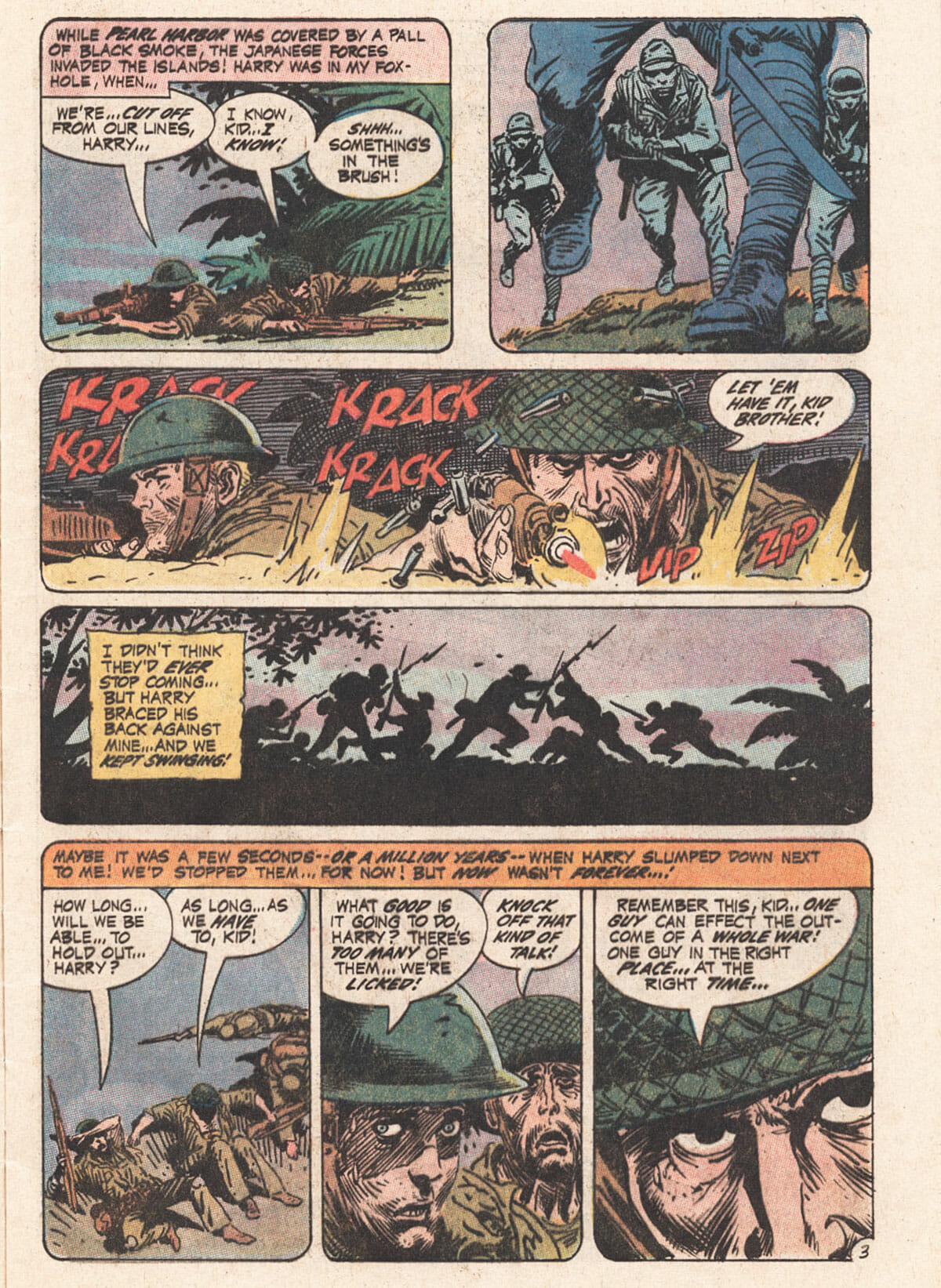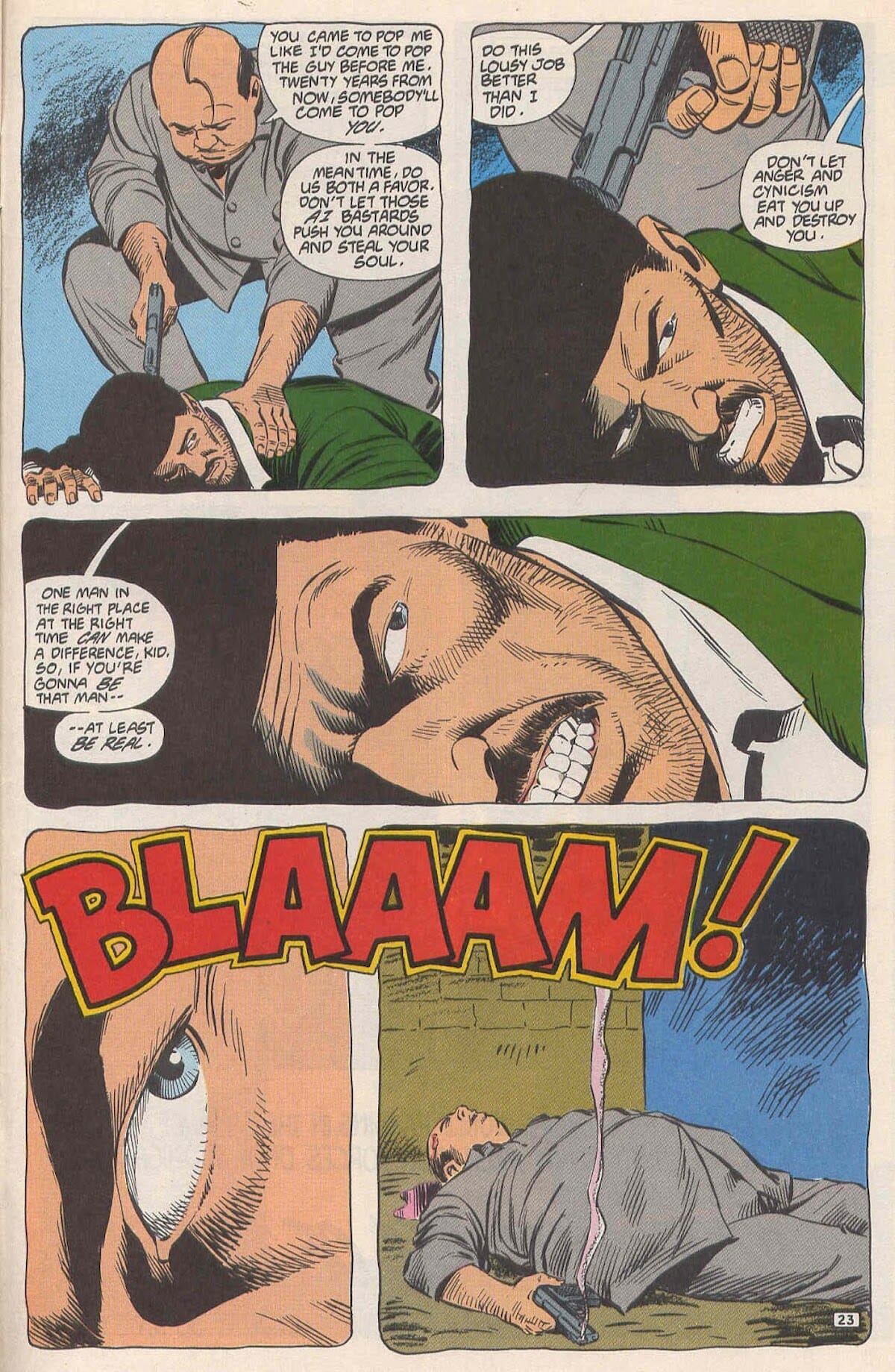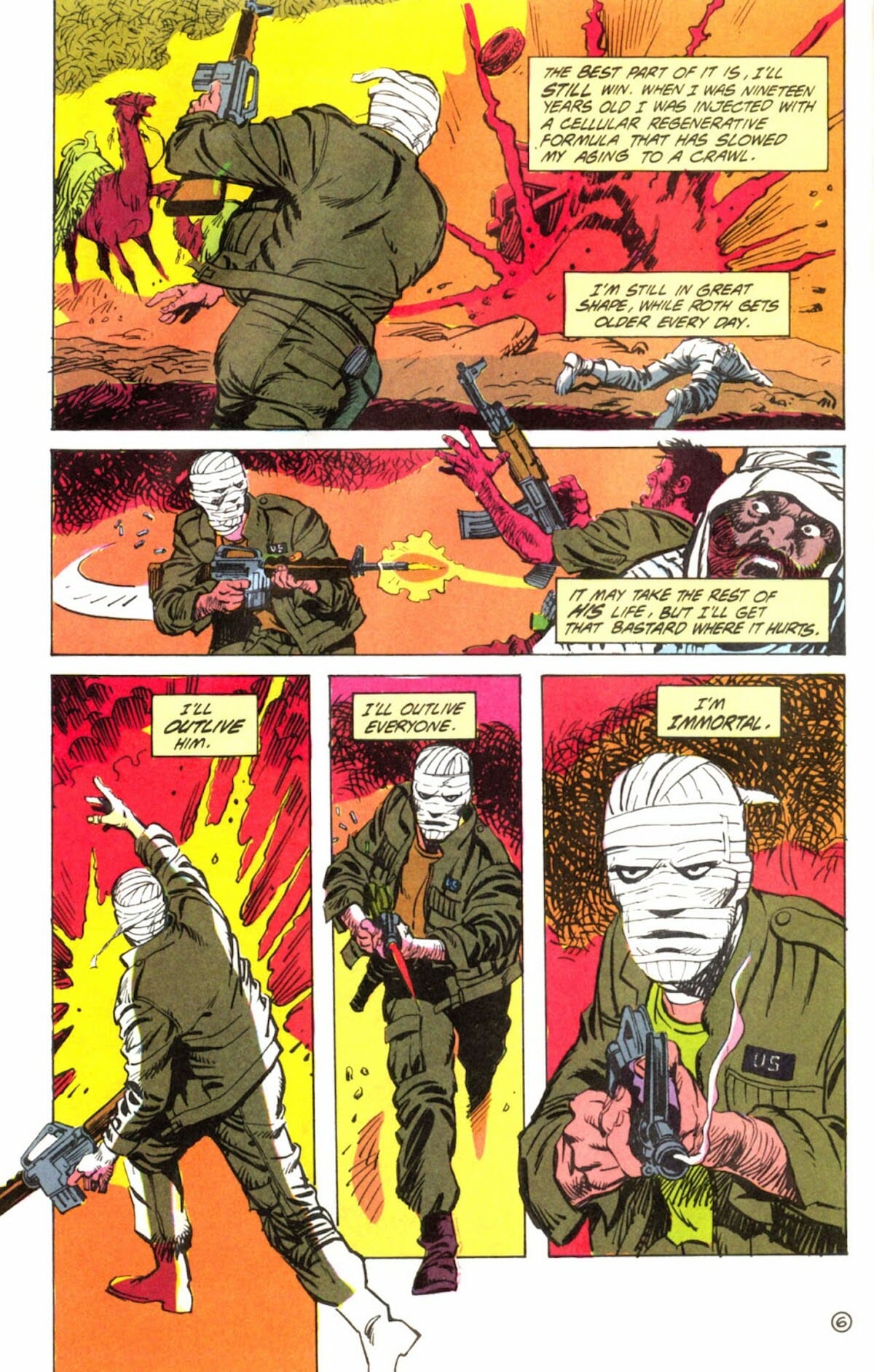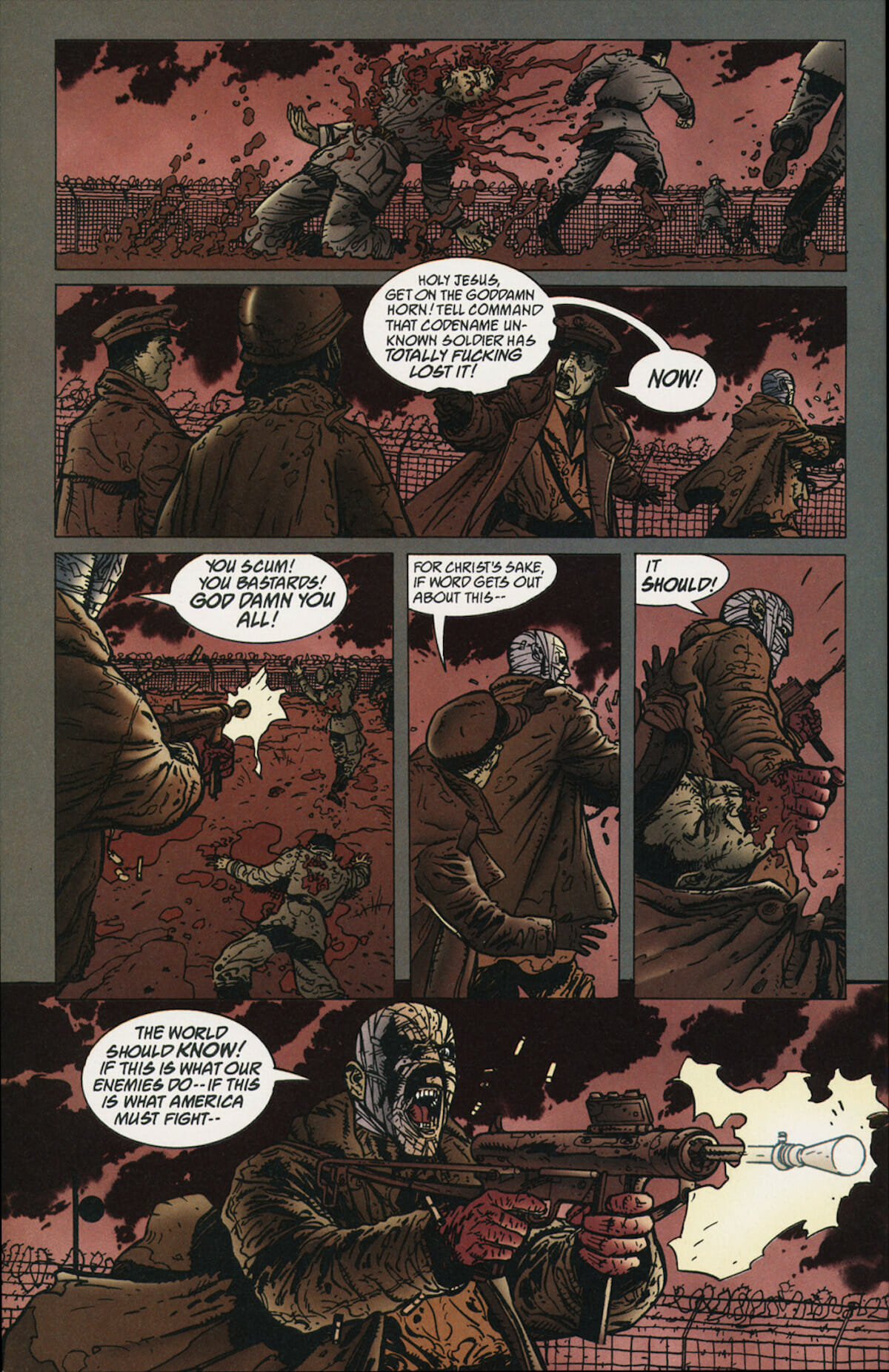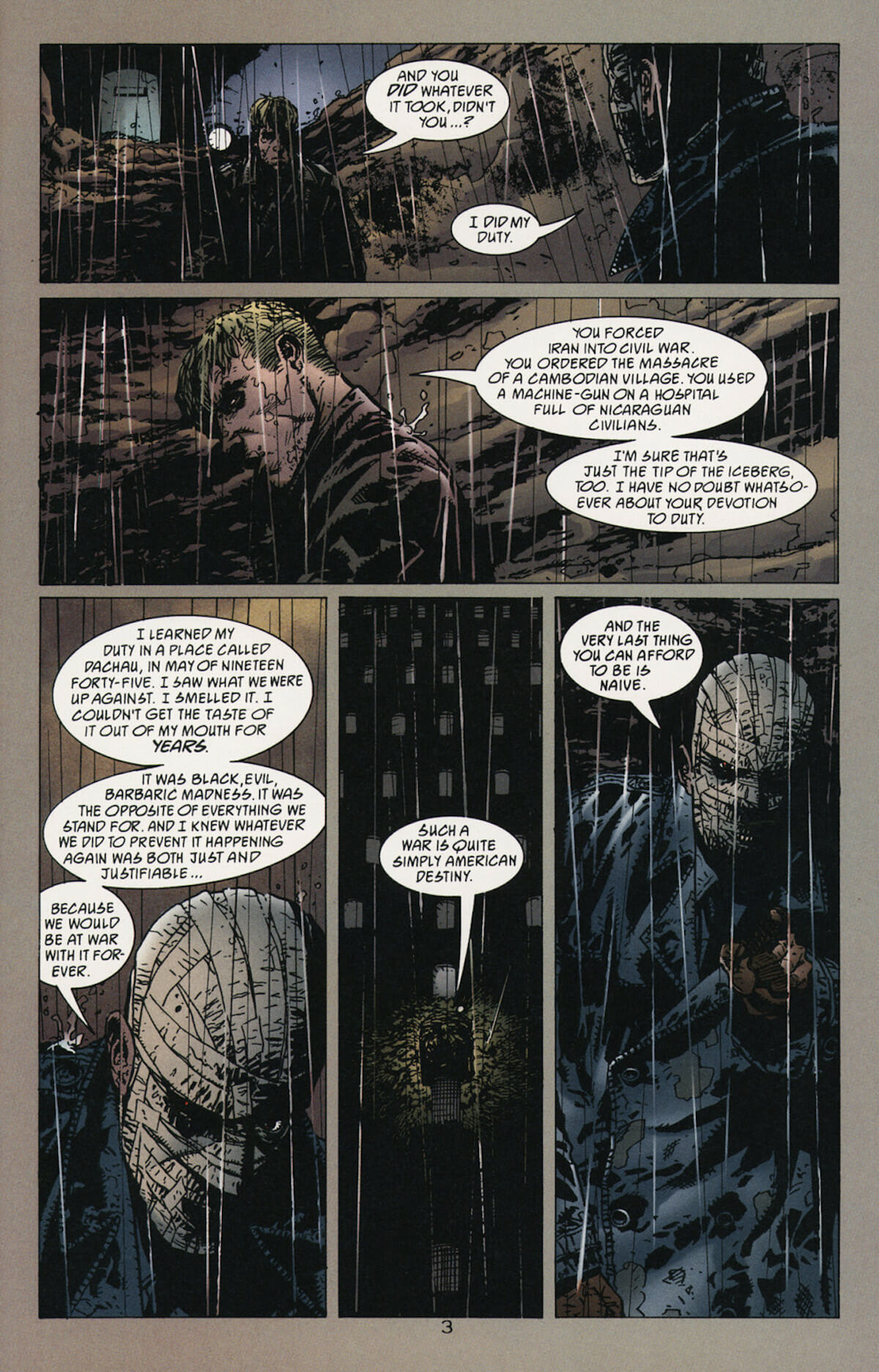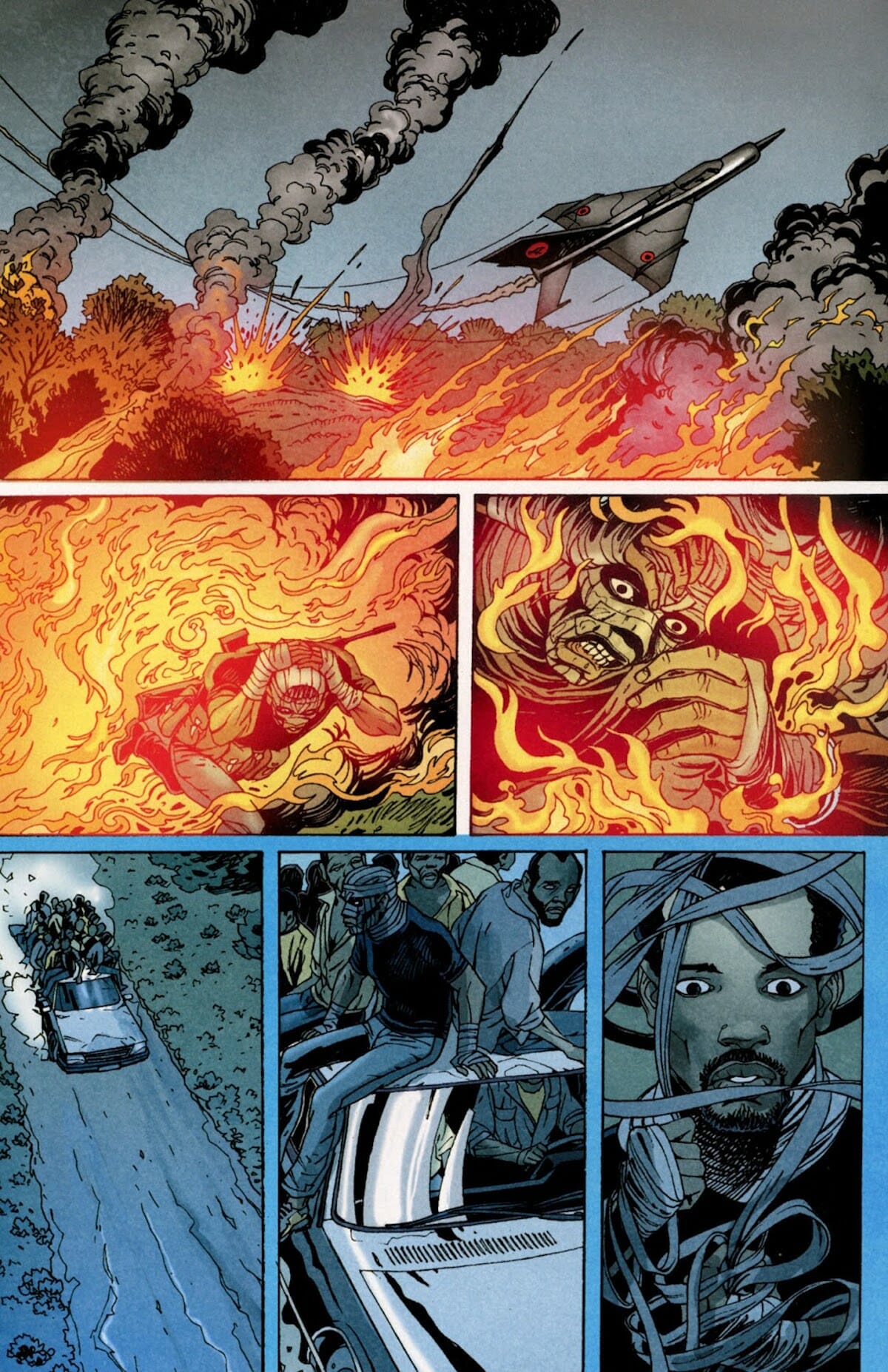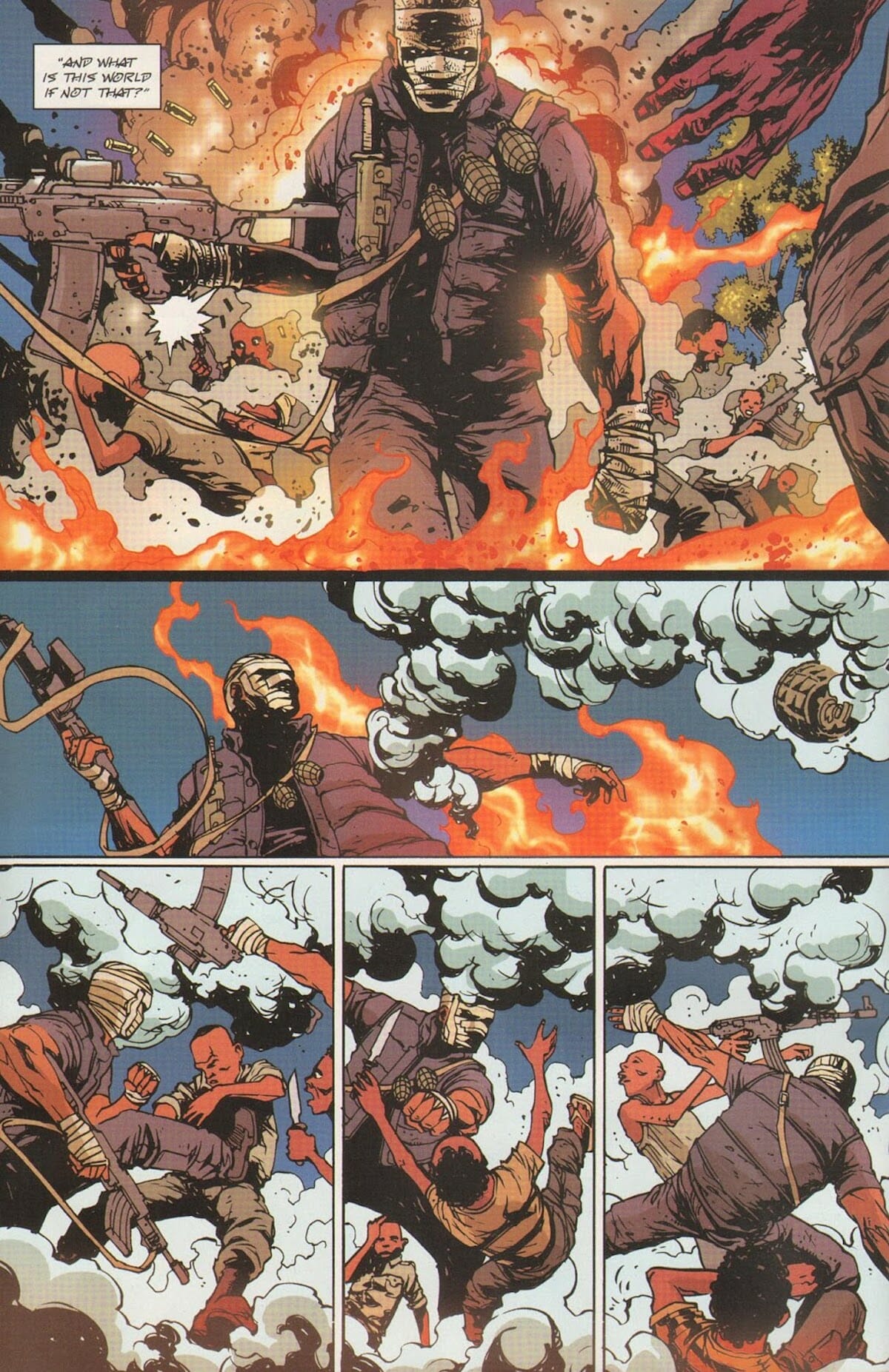It was meant to be a one-off, but something about the concept seemed to stick with creators. Several years later The Unknown Soldier returned as the lead of the war anthology Star Spangled War Stories starting with issue #151 (July, 1970) where the unknown soldier is a bandaged man and a master of disguise that can be dropped into every role in the theater of war (pilot, foot soldier, saboteur); allowing Kubert and company to play with different sub-genres of war stories. Since then the character, a perennial DC Comics c-lister, has been resurrected several times to star in several series and mini-series.
He’s never brought back in a straightforward manner. What seems to appeal to every new creator is the visual, the notion of a soldier that can be anyone. Through that figure, and through the changing decades, it is possible to view the changing face of war in the sphere of American comics, how a romantic idea of fighting and dying for one’s (always justified) country metamorphosed into a more cynical examination of foreign policy.
Generation One
The original version of the Unknown Soldier as seen in Star Spangled War Stories #151 is a rather generic story in which the soldier is called to lead a daring air raid against Japan. It would take until issue #154 before we get any sort of origin story. The soldier is one of two brothers who served together in World War II, and when his brother dies in the accident that scars his own face, the Unknown Soldier swears to fight on in his memory: “one guy can affect the outcome of a whole war! One guy in the right place… at the right time…”
The series continued thusly until issue #268 (it was renamed Unknown Soldier halfway through) with Joe Kubert penciling the early stories and Bob Kanigher writing. Soon the series changed hands to Archie Goodwin, Dick Ayres, David Michelinie, Gerry Talaoc, and others. You would think that coming out during the height of the Vietnam war, with public opinion at home turning slowly from the ‘rah rah patriotism,’ that the series would reflect that in some manner – and maybe in later issues this is true – but during the early days of Kubert, the series was very much a retrograde affair.
The story was set in World War II – the ‘good war’ – allowing for the creators not to worry about any unfortunate shades of gray that might spoil the triumphant attitude that still governed DC war comics at the time where America is always good. In “Invasion Game” (Star Spangled War Stories #155) the Unknown Soldier has to cooperate with a Black American soldier who leads a group of French resistance fighters. When asked why he isn’t in the regular military the resistance leader answers bitterly “I was a top sergeant in the U.S. army… until I was railroaded into a court martial.”
It’s an easy layup for a story about prejudice, the kind of thing EC comics did easily fifteen years earlier in Two-Fisted Tales. You would expect the Unknown Soldier to learn to accept that his country can sometimes do something wrong, but instead he dismisses all complaints as sour grapes; the Black soldier is the one who learns a lesson (“We’re still part of the same country”) because America is always right.
The Unknown Soldier himself isn’t much of a character, despite the tragic backstory and the facial scars because he’s expected to be all things to all people. He’s a blank slate. In every story he plays a brave soldier that might have a different role, but they are all cut from the same generic heroic cloth.
What really makes the series stand out in this respect, however, is Kubert’s art. Take that origin story – “I’ll Never Die” – the depiction of the fateful grenade impact that kills one brother and scars another is a beautifully constructed piece: one soldier crawls closer and closer to the grenade before it explodes and engulfs the panel in a flash blinding white light. Or a page in “Take My Coward’s Hand” (Star Spangled War Stories #162), which shows a fearful soldier walking towards the reader in a series of four long vertical panels, the focus narrows around his body until he seems locked in by the borders of the panel. All that fine art can’t cover the faults of the story, the generic hold in its heart, the soldier remains unknown because he’s not really worth knowing.
It’s A Different War, Charlie Brown
After the end of his series in 1982 the Unknown Soldier lay dormant for six years. It was the cynical 1980’s and old war propaganda felt even more out of place than in the rebellious 1970’s. War comics were a thing of the past, anyway, the genre giving way to other fads. Still, in the spirit of pre-Vertigo popular reinventions of old concepts such as Animal Man and Sandman, someone set out to prove that old soldiers never die. Christopher Priest (then known as Jim Owsly) –fresh from Marvel Comics – and artist Phil Gascoine (a veteran of the British war comics scene) teamed-up for a 12 issue series of The Unknown Soldier.
Some of the plot points remain the same, he’s still a World War II soldier who lost both his brother and his face in an explosion, but Priest and Gascione change many things. The first, and most obvious, is giving him super powers (the result of experimentation by Japanese military forces). He’s super-strong (but not like the Hulk), super-fast (but not like the Flash) and can heal quickly (but not like wolverine). These feel like genre-tapping bolted onto the concept – he still does most of his fighting with guns and grenades and you could certainly do the same story without them. What is important to the story is that he’s immortal – still looking like a fresh-faced recruit all the way into 1989.
The other major shift is the level of cynicism. This series has a bleak worldview: the world is a horrible place governed by realpolitik. True believers are fools, pawns of the people who truly run the show. The Unknown Soldier is the unwitting pawn of both the CIA (in the form of annoying agent Barry) and Army Intelligence (represented by the more sinister Roth), who keep sending him to missions representing various interests of the United States across the decades – from Korea to Vietnam to Afghanistan.
Yes, just like Rambo the Unknown Soldier is assisting Taliban warriors. Unlike Rambo, however, the Unknown Soldier doesn’t buy into their struggle. He doesn’t buy into anything really – especially ideology. Immortal life and the endless wars waged by his secret paymasters has made him a cynic amongst cynics. In its heart the series is probably the darkest of all iterations of the concept.
And why wouldn’t it be? In 1989 Reagan was out of the White House and upon his popularity the continuing rule of the Republican party was guaranteed. The Iran-Contra was already public knowledge, but that didn’t really seem to damage the government. Some heads rolled, but they were all heads of the easily-disposable. The president still sat safely in his chair and people didn’t even need to pretend to believe in anything.
The Unknown Soldier is not just preoccupied just with America though. It’s scope is global. The USSR is portrayed as just as equally rotten: “The CIA are evil, nasty people who have no souls. The KGB makes the CIA look like girl scouts” (The Unknown Soldier #6). Soviet communism is just as much a façade as America’s promise of global freedom.
The series was never reprinted. This is an ongoing (and annoying) trend with Priest’s work in DC (see also – The Ray, Steel, Justice League Taskforce), but it’s also something that feels understandable in an objective sense. All this knowing bitterness makes the series feel rather like a one-note affair. This Unknown Soldier, just like his patriotic predecessor, is also unable to evolve or change. Despite being immortal, he feels like a mark of time (the 1980’s) whose time has long passed.
The War at Home
Unknown Soldier vol. 3 is the shortest of all iterations, and also the best-focused. A four-issue miniseries written by Garth Ennis (who at this point is still riding high on the success of Preacher) and drawn by Kilian Plunkett – artist of many a-Star Wars comic, who make the rather smart choice of looking at the Unknown Soldier from an outside perspective. The protagonist of the series is CIA agent Clyde, the sort of straight-arrow, honest-to-a-fault type that immediately gets on the nerves of everyone in the office who fails to understand what his problems are with a few dead kids.
By happenstance Clyde gets on the trail of a mysterious bogeyman figure, codename ‘The Unknown Soldier,’ who’s seemingly involved with every war crime committed by the United States abroad over the last fifty years –and there are a lot of them. In many ways this work feels like a lay-up for later Ennis work, especially Fury: My War Gone By, in which old American war characters could be used as a prism to examine the USA self-justified heroic image. If Priest writes the Unknown Soldier as a true cynic, Ennis has a much scarier vision: the Unknown Soldier as a true believer.
After witnessing the horrors of World War II this person – this being – decided that America is the absolute good guy, which effectively means his country is granted an endless moral license: “If This is what our enemies do – if this is what America must fight – then we are always right. And anything we do is right.” Which is a rather decent analysis of the way America sees itself, on a global scale.
The cowboy image, as seen in countless movies, TV shows and comic books, is about a man who rides into town and does what needs to be done. The cowboy is always right, as if guided by god, and whose bullets would never hit an innocent. Everyone killed must’ve had it coming, or was a justified victim of the greater good. In this respect, while Ennis is often seen as a cynic, which is a misjudgment of his writing, I see him as a constantly disappointed optimist.
A cynic wouldn’t believe anything better is possible, as it is in the Priest/Gascione run, but here the whole moral thrust of the story is how Clyde reacts to everything the Unknown Soldier has done. Because it was all a test, an engineered journey through the Atrocity History of America, to make Clyde as cynical as him. To make Clyde agree to the impossible request, to be the next in line, to be a new Unknown Soldier. And Clyde refuses him. Having seen, he does not accept what is as what should be. He dares to expect something better from his country.
Elsewhere, Perhaps
The 2000’s seemed like as good a time as any to resurrect The Unknown Soldier. The War on Terror was omnipresent in the media, so it seemed like a matter time before someone would come with the right idea to Vertigo. But there were two surprises: it took until 2008, and the series was not about the War on Terror. It was hardly about America at all. Joshua Dysart and Alberto Ponticelli’s 25 issues series takes place mostly in Uganda and concerns a pacifistic man, Doctor Moses Lwanga, whose mission of mercy is constantly interrupted by violent dreams.
Witnessing one atrocity too much in the hand of (real life group) The Lord’s Resistance Army Moses scars his face, dons the iconic bandages and sets out on a mission to kill as many LRA soldiers (even if they are mostly children) in his path to assassinate their leader Joseph Kony. There’s a definite worry about reading about a bunch of white creators doing a story about Africa (though one of the artists who worked on the series is the Congolese artist Pat Masioni), and while I am certainly not the right person to judge if there series does any grievous errors in depiction, it appears to actually and genuinely try to get it right.
It takes place not in some mythical version of Africa but in a particular time (early 2000’s) and place (Uganda) and concerns named groups from that region (mostly the Acholi people). A couple of years later the LRA would become famous in the west for one hot minute thanks to the Kony 2012 documentary, making Kony an obvious target; but The Unknown Soldier came out before most readers in America could expect to know who Kony is.
That’s the most interesting thing about the series. There’s a CIA presence, and towards the end efforts are made to tie Moses to the original Unknown Soldier, but overall, this is a story about Africa, taking place in Africa with African protagonists and antagonists. As Moses says in issue one: “Africans must demand this. Not Americans, not the E.U., not the Asians or Russians or Arabs. Africans must change Africa, and they must do so without violence.” There’s a certain degree of irony in reading these words, knowing they come from an American writer.
I think the series is, at least somewhat, aware of that irony. As the series rushes towards conclusion (indeed, you feel the ending was announced with little leading time) we learn Moses is actually creation of the American establishment, an attempt of the original Unknown soldier to make an inversion: A Random Ugandan-American soldier, a man born into violence whose life was only war, taught to be the ultimate vessel for peace. However, once he’s exposed to the conflict in his home country his violent side surfaces again, slowly taking over from the peaceful Moses persona (we remember the Biblical Moses, who solved his problems with blood and locusts and mass death). There’s something of the hubris of America’s approach to global policy, thinking one can simply declare “mission accomplished.”
In this version of The Unknown Soldier war is exactly this. The darker impulses we deny, the belief that we can truly make a world in which all the horrors are swept beneath the rug. Dream big and enough and utopian enough – The American Dream –and you can become unmoored from the cruel demands of reality. Only a man as perfect as Moses Lwanga could hide something as terrible as the Unknown Soldier beneath his peaceful façade.
Scratch the American Dream down the core, remove the bandages that hide it, and see it’s true face throughout every decade that we have seen the Unknown Soldier – war never ends.
